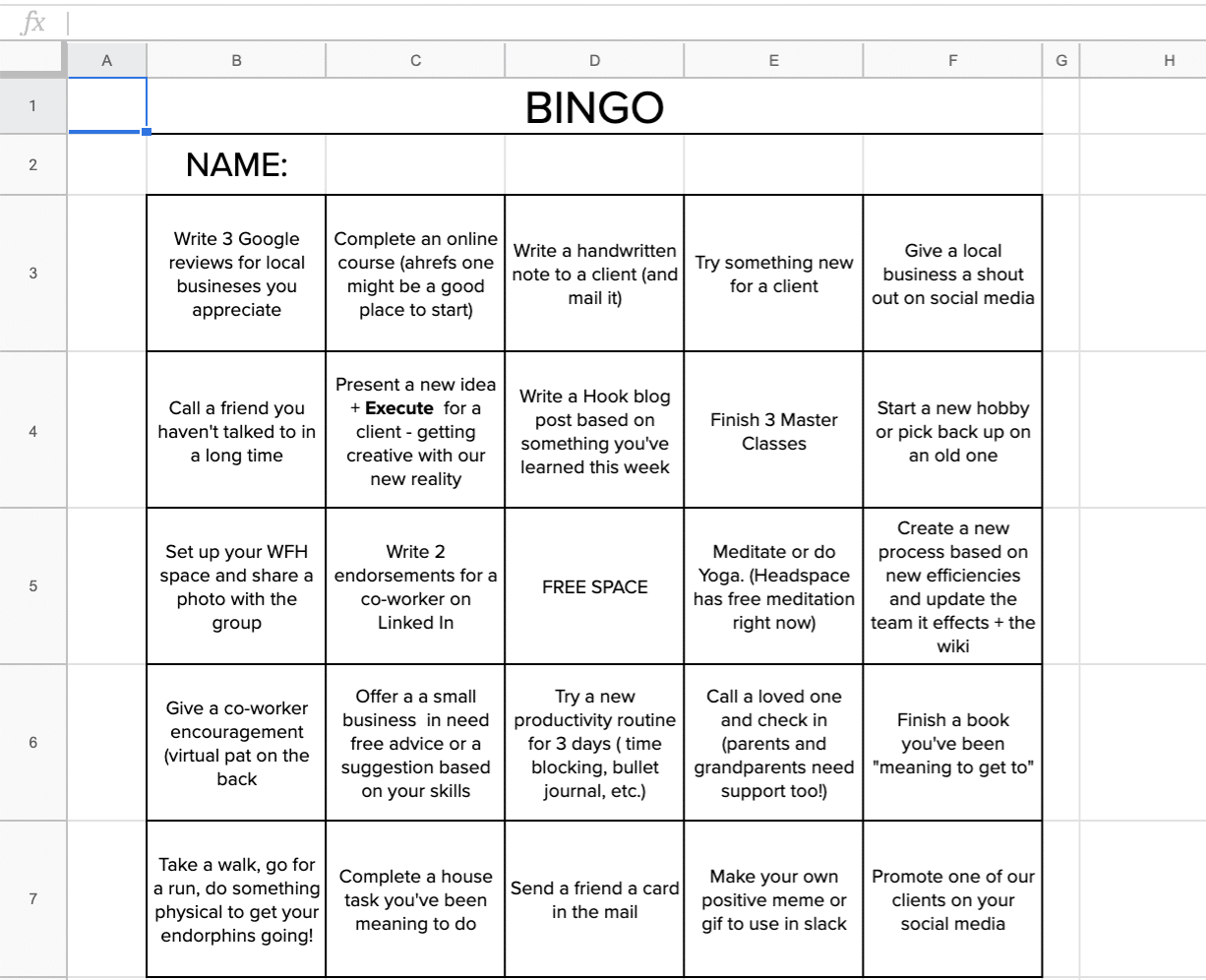We all want to have amazing company cultures. But in a moment of crisis, when we’re all forced to work remotely – it becomes so clear so quickly what doesn’t matter (office, perks, & cute shit) that our real company cultural strength is laid bare, painfully or miraculously.
- This article I’ll be curating the best tips I’ve seen for maintaining your company culture while the team is working remotely (and perhaps suddenly.)
- If you didn’t care about company culture before the pandemic – it might be a great time to start. Micro-managing is really hard when everyone has access to Netflix at their fingertips and no supervision.
- What are your core values? Will they carry you? What kind of fun challenges, new habits, and infrastructure can you put in place when nothing else matters but the work.

In addition to making a company more fun to work at, a strong company culture is strongly associated with profit. For more check out: Inc.com – 3 Ways Company Culture Directly Impacts Your Bottom Line

1. Now more than ever – people need clear weekly goals and structure around accountability
We love Traction/EOS’s structure, and have quarterly goals and check in on weekly habits with our teams on how we did each week. Everyone has 3 rocks – that are all tied to our companies top goals around effectiveness, client acquisition, and profit.
“Having clear goals that you know are impacting your business internally, as well as your clients, are more important than ever. Right now it’s easy to get distracted from what things actually move the needle. That’s why we set quarterly goals and work towards, and check in on them on a weekly basis to stay on track.
Holding each other accountable has been huge for us. We enter in our to-do list for the day in Slack, and cross off which tasks we completed at the end of the day so everyone can see it. Being held accountable seems to cut through time and effort being placed in unproductive activities. Knowing your peers are counting on you and expecting you to hold up your end of the bargain, is insanely motiviating. By showing each other which tasks we are completing every single day, our productivity has increased.” – Cole Storley, Hook Agency
2. Increase Check-in’s
“Increase check-ins with your team to see how they are doing emotionally and how they are dealing with everything. While it may not sound like it is about the culture it gives tour team reassurance that you care so they can continue to knock the culture out of the park.” – Adam Lofquist, EIG.org
3. Work from home Bingo
We found that doing a challenge to innovate, do online courses, and do local shootouts for local businesses help keep our spirits high during the first 2-3 weeks of lockdown. Each person that completed it got some kind of gift card for local restaurants who are struggling during ‘shelter in place’, and the first couple people to finish got bigger gift cards ($100 or so.)
Steal our work from home bingo template! 🙂

4. Slack, Zoom, & Getting onboarded and cleaning up your remote working tools
Highfive suggests “Choosing tools that match the culture and foster communication.” We use Google Meet rather than zoom because it’s currently integrated with our calendar app – and slack has been huge for decreasing email. You just have to find a FEW tools that maintain that continuity, and honestly – I really believe if companies that didn’t have these systems in place before getting them in place well and use them, they’ll be much better set up for the long haul.
- Slack is better than e-mails because it’s quick and not bureaucratic.
- Video chats sometimes make way more sense and take way less time than in-person meetings.
5. Gifs, Meme’s, #random slack channel
Slack isn’t just for business. In fact, gifs – emoji’s, and memes are actually great for continuing to communicate nuance and solidarity in this crazy time.
Get fluent in meme culture (a couple of my personal favorites are @middleclassfancy & @trashcanpaul) and capture *most* of the nuance of human emotion, by learning the subtle art of emoji pairing.
- Make your own gifs with Giphy desktop app
- Put subtitles on them with EZGif.com
- Or – just add random gifs to slack with /giphy command then your word
This particular gif is from our *mostly fictional* series – The Agency, binge watch season 1 – on Youtube.
6. Humorous games + happy hours
Yes – we all have Zoom / Google Hangouts exhaustion right now, but sometimes you just got to mix in some completely fun time.
- Tee KO from Jackbox games – Particularly the shirt game is stellar.
- Play ‘Secret Hitler’ online – we loved playing the in-person version of this at our yearly kickoff, but now there’s an online version!
- Houseparty – Everyone’s doing it – still haven’t actually played this yet, but yeah. Games with friends incorporated with video chat, on your iPhone.
Making space to just chillax, with no agenda – still is important. Just find ways to keep people engaged, rather than a sad 15 min “hey what’re you drinking,” and then goodbye. Games are a great way to do that + we all need a good laugh right now.
7. Don’t ignore the negative effects of isolation, be there for people
We know that there isn’t just positive stuff going on during all of this – and if you are good with working from home – some other people may not be. Check-in with each employee to see how they are handling it, and do rhythmic, rolling check-ins every couple of weeks to see how they are holding up. Help them get re-connected if they start to feel socially isolated.
8. Daily Instagram takeover by employees 🙂
Perhaps you give people some inspiration for the types of things they might show:
Description: Some ideas / Instagram prompts.
Please do at least 5 stories during the day and please do #4 at least once 🙂
- Your cute animals.
- Your work-from-home set-up.
- Your creative cooking/coffee ideas.
- Do one ‘How I stay productive working from home tip’ and then we’ll turn that into a blog post.
- Feel free to do one at night – about how your killing the boredom during quarantine 🙂
9. Ask if people need anything and go above and beyond
Mike Grinberg of Proofpoint Marketing says they’ve done the following “1. Purchased grocery delivery subscriptions (their choice of Shipt or Instacart). For $100/person it’s well worth it, especially if you have anyone that has extra anxiety about the danger of the virus 2. We just scheduled a wellness workshop, with a health/wellness consultant 3. Mandatory days off – people aren’t really taking time off right now because there is no “vacation” but it’s still important for people to spend some time on themselves, so we are forcing everyone on the team to take a few days off every month”
A few management principles I’ve seen be helpful during work from home
1. ROWE – Results only work environment
The funny thing some managers and leaders end up doing – is registering unconsciously all of these little things employees do that don’t have to do with the RESULTS. The social interactions, the interplay with co-workers, and ‘seeing the process’ someone took to get the answers they got. But this isn’t 8th-grade math, and ‘showing your work’ is less important when it comes down to getting a RESULT.

Perhaps this will all give us a moment to focus on that truth, rather than be flooded with tons of unrelated data points that often distract us from the reality of an employee/teammates results.
2. Give them the result you want, and let them own the process
Mad’s Singer (a coach for SEO Mgmt) Management Academy focuses on this approach. He says that company owners and managers often try to create processes when what they need to do is have employees own those processes. Through working with him, we made the decision to have each ‘department head’ at our company revise and sign of on the ‘standard operating procedures’ for their department each quarter. We’ve also ensured that we’re focused on having each employee own the result rather than every aspect of the process. Which ensure’s the millions of micro-decisions each week are in the direction of the result we want for our company & our clients. (For us that result is MORE & BETTER LEADS + CLOSED BUSINESS)
3. Regular 1on1’s
Not a bad time to revisit this – but if you don’t have a 1on1 weekly rhythm for every one of your employees – you may want to consider it. Originally, in my experience – this allowed me to keep an eye on the personal lives and motivation of employees – but it’s grown as an opportunity to help buy-in and ownership of leaders and their departments.
This weekly rhythm helps your team creatively work through problems at set times rather than waiting for them to pile up, or miscellaneously rear their ugly heads.
Mourn the loss of the random interaction + reap the rewards of unadulterated focus
- What are you experiencing that is way better than when you were all working in office?
- Can you focus on those things and push into them for now?
We certainly have some things improve dramatically, and while I don’t want to overlook the negatives – it’s time to own the new reality, and make your culture great (beyond the fluff of perks.) I would love your take on all this – comment below with your favorite way to keep your culture connected.
















